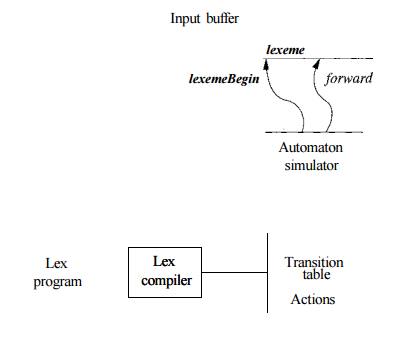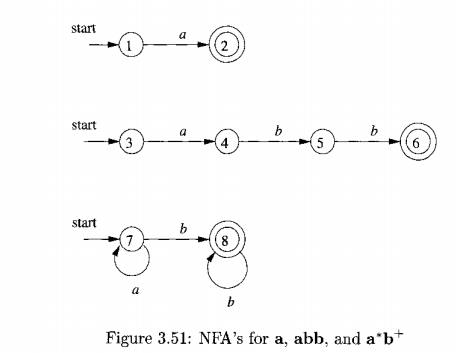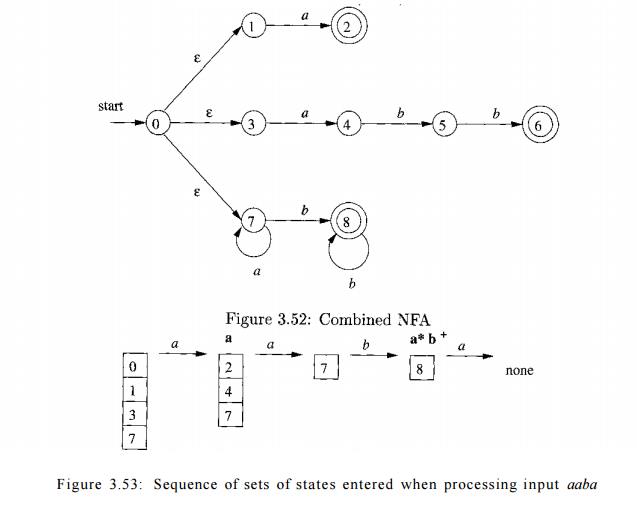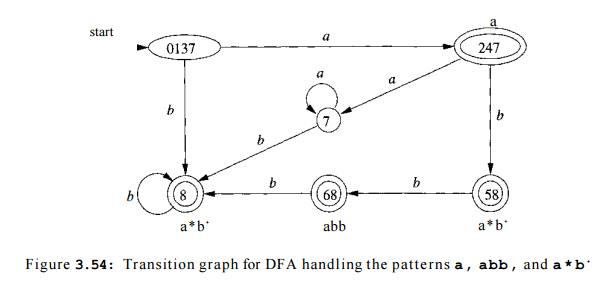Chapter: Compilers : Principles, Techniques, & Tools : Lexical Analysis
Design of a Lexical-Analyzer Generator
Design of a Lexical-Analyzer
Generator
1 The Structure of the Generated
Analyzer
2 Pattern Matching Based on NFA's
3 DFA's for Lexical Analyzers
4 Implementing the Lookahead
Operator
5 Exercises for Section 3.8
In this section we shall apply the techniques presented in Section 3.7
to see how a lexical-analyzer generator such as Lex is architected. We discuss
two approaches, based on NFA's and DFA's; the latter is essentially the
implemen-tation of Lex.
1. The Structure of the Generated
Analyzer
Figure 3.49 Overviews the architecture of a lexical analyzer generated
by Lex. The program that serves as the lexical analyzer includes a fixed
program that simulates an automaton; at this point we leave open whether that
automaton is deterministic or nondeterministic. The rest of the lexical
analyzer consists of components that are created from the Lex program by Lex
itself.

Figure 3.49: A Lex program is turned into a transition table and
actions, which are used by a finite-automaton simulator
These components are:
A transition table for the
automaton.
Those functions that are passed
directly through Lex to the output (see Section 3.5.2).
The actions from the input
program, which appear as fragments of code to be invoked at the appropriate
time by the automaton simulator.
To construct the automaton, we begin by taking each regular-expression
pattern in the Lex program and converting it, using Algorithm 3.23, to an NFA.
We need a single automaton that will recognize lexemes matching any of the
patterns in the program, so we combine all the NFA's into one by introducing a
new start state with e-transitions to each of the start states of the NFA's N{ for pattern pi. This construction is shown in Fig. 3.50.
Example 3 . 2 6 : We shall illustrate the ideas of this section with the
following simple, abstract example:

Note that these three
patterns present some
conflicts of the type discussed in Section 3.5.3. In particular,
string abb matches both the second and third patterns, but we shall consider it
a lexeme for pattern p2, since that pattern is listed first in the above Lex
program. Then, input strings such as aabbb • • •
have many prefixes that match the third pattern. The Lex rule is to take
the longest, so we continue reading 6's, until another a is met, whereupon we
report the lexeme to be the initial a's followed by as many 6's as there are.
Figure 3.51 shows three NFA's that recognize the three patterns. The
third is a simplification of what would come out of Algorithm 3.23. Then, Fig.
3.52 shows these three NFA's combined into a single NFA by the addition of
start state 0 and three e-transitions. •
2. Pattern Matching Based on
NFA's
If the lexical analyzer simulates an NFA such as that of Fig. 3.52, then
it must read input beginning at the point on its input which we have referred
to as lexemeBegin. As it moves the
pointer called forward ahead in the
input, it calculates the set of
states it is in at each point, following Algorithm 3.22.
Eventually, the NFA simulation reaches a point on the input where there
are no next states. At that point, there is no hope that any longer prefix of
the input would ever get the NFA to an accepting state; rather, the set of
states will always be empty. Thus, we are ready to decide on the longest prefix
that is a lexeme matching some pattern.


We look backwards in the sequence of sets of states, until we find a set
that includes one or more accepting states. If there are several accepting
states in that set, pick the one associated with the earliest pattern pi in the list from the Lex program. Move the forward pointer back to the end of the
lexeme, and perform the action Ai
associated with pattern pi.
Example 3 . 27: Suppose we have the patterns of Example 3.26 and the input begins aaba. Figure 3.53 shows the sets of states of the NFA of Fig. 3.52
that we enter, starting with e-closure
of the initial state 0, which is {0,1,3,7}, and proceeding from there. After
reading the fourth input symbol, we are in an empty set of states, since in
Fig. 3.52, there are no transitions out of state 8 on input a.
Thus, we need to back up, looking for a set of states that includes an
accepting state. Notice that, as indicated in Fig. 3.53, after reading a we are
in a set that includes state 2 and therefore indicates that the pattern a has
been matched. However, after reading aab, we are in state 8, which indicates
that a * b + has been matched; prefix aab is the longest prefix that gets us to
an accepting state. We therefore select aab as the lexeme, and execute action
A3, which should include a return to the parser indicating that the token whose
pattern is p3 = a * b + has been found. •
3. DFA's for
Lexical Analyzers
Another architecture, resembling the output of Lex, is to convert the
NFA for all the patterns into an equivalent DFA, using the subset construction
of Algorithm 3.20. Within each DFA state, if there are one or more accepting
NFA states, determine the first pattern whose accepting state is represented,
and make that pattern the output of the DFA state.
Example 3 . 2 8 : Figure 3.54 shows a transition diagram based on the DFA that is constructed by the subset
construction from the NFA in Fig. 3.52. The accepting states are labeled by the
pattern that is identified by that state. For instance, the state {6,8} has two
accepting states, corresponding to patterns abb and a * b + . Since the former is listed first, that is the pattern associated with state {6,8} . •
We use the DFA in a lexical analyzer much as we did the NFA. We simulate
the DFA until at some point there is no next state (or strictly speaking, the
next state is 0, the dead state corresponding to the empty set of NFA states). At that point,
we back up through the sequence of states we entered and, as soon as we meet an
accepting DFA state, we perform the action associated with the pattern for that
state.
Example 3 . 2 9 : Suppose the DFA of Fig. 3.54 is given input abba. The se-quence of states entered is
0137,247,58,68, and at the final a
there is no tran-sition out of state 68. Thus, we consider the sequence from
the end, and in this case, 68 itself is an accepting state that reports pattern
p2 = abb . •

4. Implementing the Lookahead
Operator
Recall from Section 3.5.4 that the Lex lookahead operator / in a Lex pattern r\/r2 is sometimes necessary, because the pattern r*i for a particular token
may need to describe some trailing
context r2 in order to correctly identify the actual lexeme. When converting the
pattern r\/r2 to an NFA, we treat the / as if it were e, so we do not actually look
for a / on the input. However, if the NFA recognizes a prefix xy of the input buffer as matching this
regular expression, the end of the lexeme is not where the NFA entered its
accepting state. Rather the end occurs when the NFA enters a state s such that
1. s
has an e-transition on the (imaginary) /,
2. There is a path from the start state of the NFA to state s
that spells out x.
3. There is
a path from state
s to the
accepting state that spells out
y.
4. x
is as long as possible for any xy
satisfying conditions 1-3.
If there is only one e-transition state on the imaginary / in the NFA,
then the end of the lexeme occurs when this state is entered for the last time
as the following example illustrates. If the NFA has more than one e-transition
state on the imaginary /, then the general problem of finding the correct state
s is much more difficult.
Example 3.30: An NFA
for the pattern for the Fortran
IF with lookahead, from
Example 3.13, is shown in Fig. 3.55. Notice that the e-transition from state 2 to state
3 represents the lookahead operator. State 6
indicates the pres-ence of the keyword IF. However,
we find the lexeme IF by scanning backwards to the last occurrence of state 2, whenever
state 6 is entered. •
Dead States in DFA's
Technically, the automaton in Fig. 3.54 is not quite a DFA. The reason
is that a DFA has a transition from every state on every input symbol in its input
alphabet. Here, we have omitted transitions to the dead state 0,
and we have therefore omitted the transitions from
the dead state to itself on every input. Previous
NFA-to-DFA examples did not have a way to get from the start state to 0, but the NFA of Fig. 3.52 does.
However, when we construct a DFA for use in a lexical analyzer, it is
important that we treat the dead state differently, since we must know when
there is no longer any possibility of recognizing a longer lexeme. Thus, we
suggest always omitting transitions to the dead state and elimi-nating the dead
state itself. In fact, the problem is harder than it appears, since an
NFA-to-DFA construction may yield several states that cannot reach any
accepting state, and we must know when any of these states have been reached.
Section 3.9.6 discusses how to combine all these states into one dead state, so
their identification becomes easy. It is also inter-esting to note that if we
construct a DFA from a regular expression using Algorithms 3.20 and 3.23, then
the DFA will not have any states besides 0 that cannot lead to an accepting state.

5. Exercises for Section 3.8
Exercise 3 . 8 . 1 : Suppose we have two tokens: (1)
the keyword if, and (2) id-entifiers, which are strings of letters other
than if. Show:
The NFA for these tokens, and
The DFA for these tokens.
Exercise 3.8.2 : Repeat Exercise 3.8.1 for
tokens consisting of (1) the keyword while, (2) the keyword when, and (3) identifiers consisting of strings
of letters and digits, beginning with a letter.
! Exercise 3 . 8 . 3 : Suppose we were to revise the definition of a DFA to allow zero or one transition out of each
state on each input symbol (rather than exactly one such transition, as in the
standard DFA definition). Some regular
expressions would then have smaller "DFA's" than they do under
the standard definition of a DFA. Give an example of one such regular
expression.
!! Exercise 3.8.4 : Design an algorithm to recognize Lex-lookahead
patterns of the form r i / r 2 , where
r\ and r2 are regular expressions. Show how your algorithm works on the
following inputs:
(abcd\abc)jd
(a\ab)/ba
! aa * j a*
Related Topics